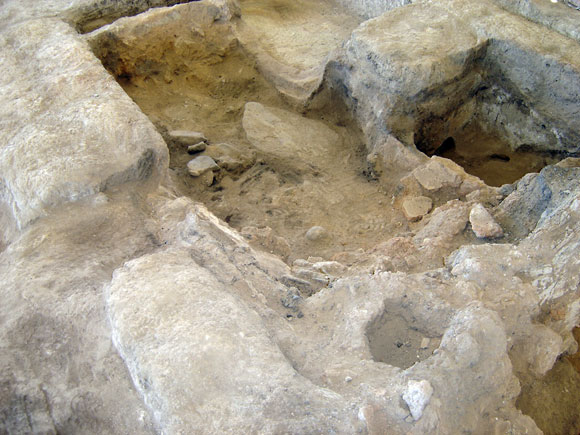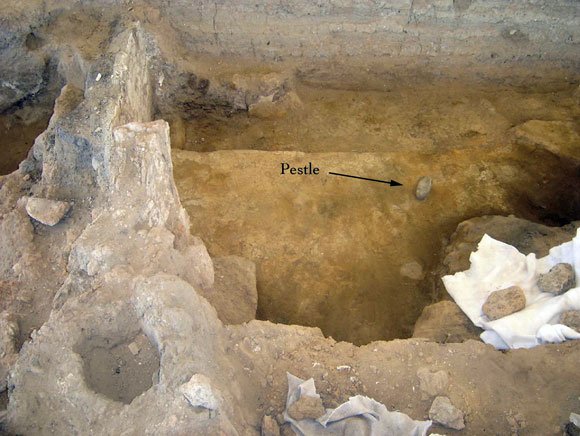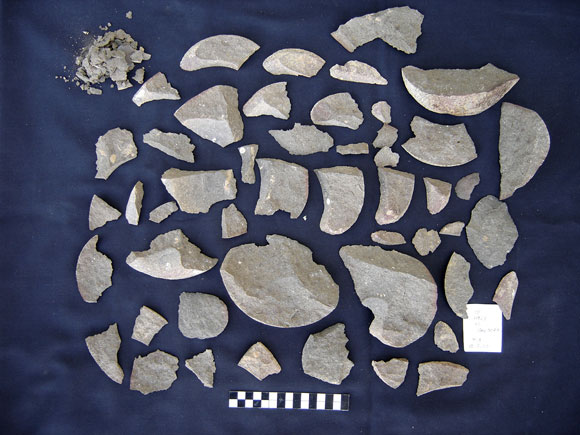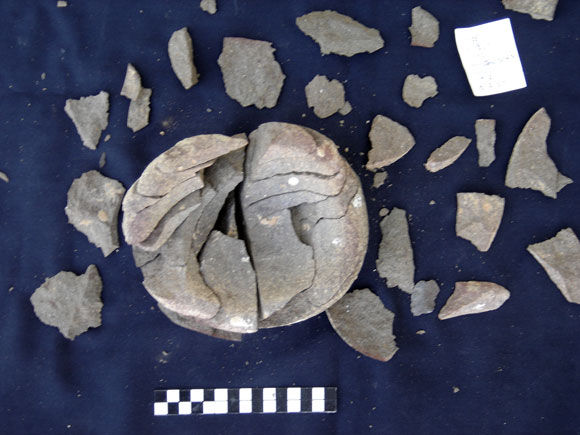ÇATALHÖYÜK 2005 ARCHIVE REPORT
| |
CULTURAL AND ENVIRONMENTAL MATERIALS REPORTS
Ground Stone Studies
Institute of Archaeology
University College London
Department of Archaeology
University of Liverpool
Özet
Bu yılki kazı sezonu içerisinde yapılan çalışmalar çeşitli alanlarda yoğunluk ve artış kazanırken önceki kazı dönemlerinde belirlenmiş olan hedefler ve yöntemler aynı kaldı. Istanbul ekibinin yapmış olduğu çalışmalar bu yoğunluğu biraz daha arttırırken aynı zamanda gelecek sezonlardan itibaren öğütme taşı çalışmalarındaki bazı sorulara da ışık tutacaktır. Bu yılki önemli gelişmelerden biride 2002 sezonundan sonra Dr. K. I. Wright bu yılki çalışmalara tekrar katıldı. Bu katılım sayesinde sezonun büyük bir kısmında BACH alanından gelmiş olan tüm malzeme (1997-2003) bir kez daha ve detaylı olarak gözden geçirildi. Bu çalışma sonucunda BACH malzemesi yayına hazırlanacaktır. Bunun dışında diğer alanlardan ele geçen malzemelerde değerlendirilerek gerek kazı sürecinde gerekse aralıklarla, alan sorumlularına elegeçen malzeme hakkında bilgi verildi. Bu sezonda ağırlık verilen noktalardan bir taneside ekip üyelerine öğütme taşı çalışmaları ve bu konu üzerinde yakındoğu ve anadoluda yapılan çalışmalar hakkında daha detaylı bilgi vermek oldu. Çatalhöyük öğütme taşı çalışmalarının bölgeler arası entegrasyonu hakkında ekip üyelerine küçük bir kesit sunularak bu konuda yapılan çalışmalarının sadece Çatalhöyük için değil aynı zamanda tüm yakındoğu arkeolojik konteksti içinde de yiyecek üretimi ve taş alet endüstrisi açısından son derece önemli bir yer tuttuğu bir kez daha vurgulanmış oldu.
In 2005, the methods and aims for the studies of ground stone artifacts at Çatalhöyük were refined and expanded, building upon those established earlier in the project. ‘Team Ground Stone,’ which since 2002 has been composed of Katherine (Karen) Wright and Adnan Baysal, engaged in several key activities in the summer of 2005.
Comprehensive study of the material from Building 3, excavated by the University of California at Berkeley (BACH), in preparation for the publication of this part of the project (Wright and Baysal 2007, in preparation). All of the ground stone material from this house and its associated deposits was pulled out and the ground stone artifacts were systematically analyzed and the data entered into a working database for this house. In weekly meetings with the BACH publication team, we discussed aspects of ground stone technology, artifact use-life, spatial distribution, contextual analyses and relationships of the ground stone to other categories of finds and features. The draft of the chapter for this part of the publication will be submitted in early January 2006 and publication should follow some months thereafter. Provisional results indicate that the materials from House 3 are somewhat different from those of Building 1 and the 355 priority contexts (Baysal and Wright 2005).
Intensive studies of raw material properties, sourcing and lithic technologies are continuing, with particular focus on ground stone cores and debitage, manufacturing technology and discard (Baysal 2006, in preparation; Wright 2005, in press; Wright 1993). In particular, we organized the raw material reference collection from geological surveys of past years, into a more systematic study collection, and we began to refine our initial assessments of raw materials used for ground stone at the site. We also added to the petrological reference collection.
We are in the process of organizing analyses of residues recovered from ground stone tool surfaces in previous excavations. Samples of inorganic residues have been conserved for integration with other such studies, eg by the micromorphologists and archaeochemistry specialists on the project.
The artifact database of material from across the site is being added to and refined. We also held discussions about coordination and linking of the ground stone database to the central site database, with Mia Ridge (Museum of London), Ian Hodder and other teams. It is hoped to have full coordination very soon.
We spent several days in the Konya Museum, studying material excavated during the Mellaart years and we are very grateful to the Director of the Konya Museum for the permission to undertake this important work. The Mellaart material revealed some important surprises.
To communicate our research and its early results, we presented a lecture in Turkish and English to the project members. This led to very useful discussions with other team members.
The start of new excavation areas on site (eg Team Istanbul) is shedding new light on spatial distributions, tool typology, tool production areas, and discard of ground stone artifacts in primary, secondary and other categories of refuse. Some general observations on the areas follow.
BACH Area
The excavations in this area were conducted from 1997 onwards by a team from Berkeley University, and consisted of a thorough investigation of Building 3. This excavation is important from the point of understanding the use life history of ground stones within a single household. Artefacts from this building displayed considerable evidence of re-modification and re-use. There was an emphasis on axe production and modification within this building, but not on the scale of a workshop. Other artefacts such as querns, handstones and sanders were also curated. One of the grinding slabs, however, seems not to have been used for a very long period before abandonment. More results about the building’s tool use and life history will be reported in detail in the publication.
Area 4040
The wider opening in the 4040 area produced very rich artefact clusters. An area apparently dedicated to food preparation was found next to several sets of bull horns in one burnt room. A large quern was found in situ next to the fire place or oven area. The other artefacts beside the quern in this room were broken pieces of handstones. Because this room was exposed to heavy burning, there seem to be some well preserved plant remains, and therefore this should permit us to investigate further examination of the role of the grinding tools and whether this was truly a food preparation area (Fig. 102). Of special interest is the fact that a mortar and pestle were found in front of the bullhorns. Both pestle and mortar were found in situ on the floor, under the debris of the burnt building. Further opening of the debris also revealed that the mortar was shattered by heat, but not scattered by the collapse of heavy building material. This made it possible to reconstruct the mortar and it allows us to capture detailed information on breakage patterns of andesite under intense heat. One of us (Baysal) is looking with particular care at how the fracturing contrasts with flakes from ground stone artifact manufacture. (See Fig. 103 for the pestle and Figs. 104 and 105 for the mortar reconstruction.)
on top of the use surface of the quern seems to suggest that it might have been used with the quern, for grinding; but the combination of clay and volcanic rock for grinding tools, whilst not unknown, is rare. A more likely explanation is that this is either a deposit with some ritual significance, or simply be a coincidence of storage or deposition of the objects. In any case this was the first instance of such a juxtaposition of objects.
Figure 102. Possible food preparation area showing bin and ground stone fragments.
Figure 103. Pestle, in situ.
Figure 104. Mortar, shattered by the heavy building debris collapse onto it.
Figure 105. Reconstruction work on the heat-fractured mortar. |
Istanbul Area
The Istanbul team have excavated a wide area in this season. The exposure of some of the buildings’ walls also revealed some ground stone artefacts, some of which had been left as though they were ready to be used again at any time. Similar behaviour was also revealed in Building 1 in the North area where a slab with paint residue was left upside down within the building (Baysal and Wright 2005). One of the most important discoveries for us was an enigmatic object, made of very sandy clay, with two protruding extensions (Fig. 106). The shape could be interpreted as a pair of bull horns or a pair of breasts, but the object is particularly reminiscent of hearth decoration features (‘andirons’) such as are seen at Chalcolithic and Early Bronze Age sites in central and eastern Anatolia (eg, Beycesultan, Pulur Sakyol) (Kosay 1976; Lloyd and Mellaart 1962). The careful placement of this object
Area TP (Team Poznan)
The Area TP excavations continued this year and this is an area which generally produces large grinding tools. Amongst these tools the most noticeable thing is the size of the objects and fragments, so far, this area’s excavations have revealed the largest tools and fragments, after those of the West Mound. Some of the artefacts, such as stone trays, are reminiscent of the west mound fragments, as well as being similar both technologically and typologically to the previous examples. Similar artefacts, stone trays, are also common in the late Neolithic and early Chalcolithic periods of other sites in the vicinity.
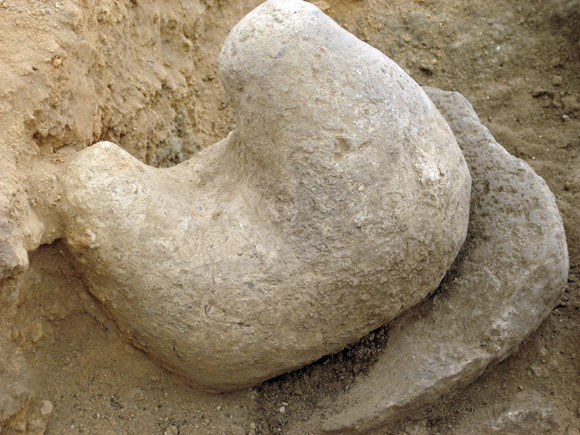
Figure 106. Clay object and grinding slab. |
Conclusion
Thus, ground stone studies continue apace at Catalhoyuk and are taking us into new directions that should shed new light on the use of stone artifacts in the Neolithic. Provisionally, we can say that patterns of discard of ground stone artifacts vary widely within Catal itself and at other sites of this age (Wright 1993; 2000). These patterns at Catalhoyuk indicate systematic recycling and refuse removal, but sometimes in special ways that do not easily fit into the well-known categories of refuse disposal such as primary refuse, secondary refuse, de facto refuse, abandonment refuse or provisional discard (Hardy-Smith and Edwards 2004; Martin and Russell 2000). We will be addressing this issue in more depth in forthcoming publications.
References
Baysal A (2006) (in preparation) Life histories of ground stone artefacts: a case study from Çatalhöyük, Liverpool: Ph.D. dissertation, Department of Archaeology, University of Liverpool
Baysal A, Wright KI (2005) Cooking, crafts and curation: the ground stone artefacts from Çatalhöyük, 1995-1999, in Hodder,I, (ed) Excavations at Çatalhöyük, Volume 5. Changing Materialities at Çatalhöyük: reports from the 1995-1999 seasons, Cambridge and London:Monographs of the McDonald Institute for Archaeological Research, University of Cambridge; British Institute for Archaeology at Ankara,
Hardy-Smith T, Edwards P (2004) The garbage crisis in prehistory: artefact discard patterns at the early Natufian site of Wadi Hammeh 27 and the origin of household refuse disposal patterns, Journal of Anthropological Archaeology 23: 253-289
Kosay H (1976) Keban Project Pulur Excavations 1968-1970, Ankara: Keban Project Publications, Series III No. 1, Middle East Technical University.
Lloyd S, Mellaart J (1962) Beycesultan, Volume I: The Chalcolithic and Early Bronze Age Levels, London: British Institute of Archaeology at Ankara
Martin L, Russell N (2000) Trashing rubbish, in Hodder,I and Members of the Çatalhöyük Teams (eds) Excavations at Çatalhöyük, Volume 2. Towards Reflexive Method in Archaeology: the Example at Çatalhöyük, Cambridge and London:Monographs of the McDonald Institute for Archaeological Research, University of Cambridge; British Institute for Archaeology at Ankara, 57-70
Wright KI (1993) Early Holocene ground stone assemblages in the Levant, Levant 25: 93-111
Wright KI (2000) The social origins of cooking and dining in early villages of western Asia, Proceedings of the Prehistoric Society 66: 89-121
Wright KI (2005) Craft production and the organization of ground stone technologies, in Rowan,Y and Ebeling,J (eds) New Approaches to Old Stones: Recent Studies of Ground Stone Artefacts, London:Equinox Archaeology Books.
Wright KI, Baysal A (2007) Ground stone tools and technologies associated with House 3 at Çatalhöyük, in Tringham,R and Stevanovic,M (eds) Çatalhöyük House 3: the Excavations of the University of California at Berkeley at Çatalhöyük (BACH), Los Angeles:Monographs of the Cotsen Institute of Archaeology, University of California at Los Angeles.
| |
© Çatalhöyük Research Project and individual authors, 2005
